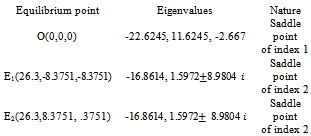-
Paper Information
- Next Paper
- Previous Paper
- Paper Submission
-
Journal Information
- About This Journal
- Editorial Board
- Current Issue
- Archive
- Author Guidelines
- Contact Us
American Journal of Computational and Applied Mathematics
p-ISSN: 2165-8935 e-ISSN: 2165-8943
2012; 2(6): 257-259
doi: 10.5923/j.ajcam.20120206.03
Forming Mechanizm of Bhalekar-Gejji Chaotic Dynamical System
Sachin B. Bhalekar
Department of Mathematics, Shivaji University, Kolhapur, 416004, India
Correspondence to: Sachin B. Bhalekar, Department of Mathematics, Shivaji University, Kolhapur, 416004, India.
| Email: |  |
Copyright © 2012 Scientific & Academic Publishing. All Rights Reserved.
Chaotic dynamical systems are used to model various natural phenomena. Bhalekar-Gejji chaotic dynamical system is a system of three ordinary differential equations containing only two nonlinear terms. This system shows two-scroll butterfly-shaped attractor for certain values of parameters. In this article we show that the two-scroll attractor in this system is formed from two one-scroll attractors. We have used a control parameter in the third equation of the system to study the forming procedure of the attractor.
Keywords: Chaos, Attractor, Limit Cycle, Synchronization
Cite this paper: Sachin B. Bhalekar, "Forming Mechanizm of Bhalekar-Gejji Chaotic Dynamical System", American Journal of Computational and Applied Mathematics, Vol. 2 No. 6, 2012, pp. 257-259. doi: 10.5923/j.ajcam.20120206.03.
Article Outline
1. Introduction
- Chaos is a phenomena observed in certain nonlinear dynamical systems. It is observed in a wide variety of systems such as Chua's circuit[1] in electronics, Belousov-Zhabotinsky reaction[2, 3] in chemistry, economics and finance[4-6], Rayleigh-Benard convection[7] in fluid dynamics, population dynamics[8], physiology[9, 10], pharmacodynamics[11] and meteorology[12]. E. N. Lorenz was the first to observe chaos in nonlinear system of differential equations. Lorenz system[12] represents convective motion of fluid which is cooled from above and warmed from below[13]. Few important examples of chaotic systems include Rossler system[14], Chen system[15], Liu system[16] and Lu system[17].Chaotic trajectories are very sensitive to initial conditions i.e. the trajectories starting nearby could have completely different future. Though there is unpredictability, it is possible to make the behaviour of two (or many) nearby starting trajectories identical after some time period. This process is done by applying a suitable control and is termed as a synchronization. Examples of synchronization are abundant in nature. For the detailed discussion on this topic, readers are referred to[18-20]. Synchronization of chaotic systems have applications in secure communication[21]. Due to unpredictability, the crypto-systems based on chaotic synchronization are difficult to decode. The review on this topic is available in[22].In this article we show that the two-scroll attractor in Bhalekar-Gejji system is formed from two one-scroll attractors. We have used a control parameter in third equation of the proposed system to study the forming procedure of the attractor.
2. Bhalekar-Gejji System
- A new chaotic system[23] proposed by Bhalekar and Daftardar-Gejji is given by the system of three ordinary differential equations.
 | (2.1) |
 , a, b are constant parameters. System (2.1) shows a chaotic behaviour for
, a, b are constant parameters. System (2.1) shows a chaotic behaviour for  =-2.667,
=-2.667,  =10, a=27.3, b=1 as shown in Fig. 1.
=10, a=27.3, b=1 as shown in Fig. 1. 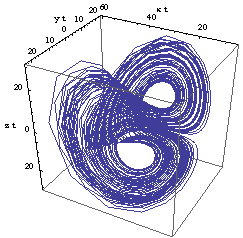 | Figure 1. Chaotic phase portrait of (2.1) |
 | (2.2) |
 are listed for the parameter values
are listed for the parameter values  =-2.667,
=-2.667,  =10, a=27.3, b=1.
=10, a=27.3, b=1.
|
 of the system (2.1) is called a saddle point if the Jacobian matrix at
of the system (2.1) is called a saddle point if the Jacobian matrix at  has at least one eigenvalue with negative real part (stable) and one eigenvalue with non-negative real part (unstable). A saddle point is said to have index one (/two) if there is exactly one (/two) unstable eigenvalue/s. It is established in the literature[24-27] that, scrolls are generated only around the saddle points of index two. Saddle points of index one are responsible only for connecting scrolls.
has at least one eigenvalue with negative real part (stable) and one eigenvalue with non-negative real part (unstable). A saddle point is said to have index one (/two) if there is exactly one (/two) unstable eigenvalue/s. It is established in the literature[24-27] that, scrolls are generated only around the saddle points of index two. Saddle points of index one are responsible only for connecting scrolls.3. Forming Mechanism of Attractor
- In order to study the compound structure of the new attractor, we add a constant gain to the third equation.
 | (3.1) |
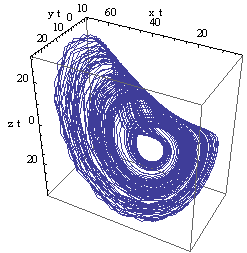 | Figure 2(a). Left attractor m=18.5 |
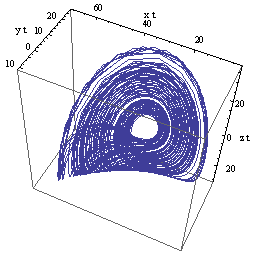 | Figure 2(b). Right attractor m=-18.5 |
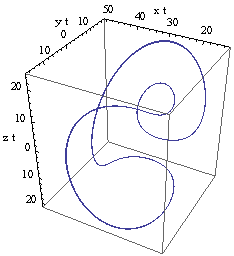 | Figure 3(a). Limit cycle for m=3.2 |
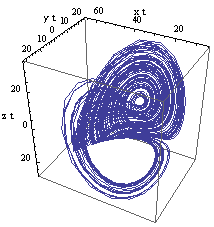 | Figure 3(b). Partial attractor m=14 |
4. Conclusions
- In this article, the forming mechanism of Bhalekar-Gejji chaotic system is discussed. It is observed that the two-scroll attractor in the Bhalekar-Gejji system is formed from two one-scroll attractors. For this study, we have introduced a control parameter m in the third equation of the system. The complete double-scroll attractor observed for |m|<3.2 is transformed to a partial attractor in the range 11.4≤|m|<18.5. Limit-cycles are also observed for certain values of parameter m.
 Abstract
Abstract Reference
Reference Full-Text PDF
Full-Text PDF Full-Text HTML
Full-Text HTML